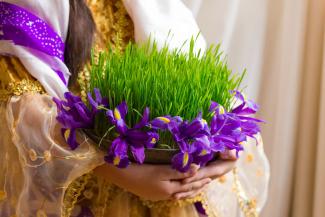
Do the preparation task first. Then read the article and do the exercises.
Preparation
What is Nowruz?
Nowruz means 'new day' in Persian and is the most important festival of the year in Iran. It is also celebrated in a number of other countries across the Middle East, Central Asia, South Asia, the Balkans and East Africa, and dates back at least 3,000 years. The holiday has changed over the thousands of years that it has been celebrated, and different regions have preserved or developed different traditions, as well as adding new ones. But wherever it is observed, it celebrates the original message of rebirth and renewal.
When is it celebrated?
Nowruz marks the spring equinox, when night and day are of equal length. This is usually on 20 or 21 March. It's the day when winter changes into spring in the northern hemisphere, and it feels like a new beginning. In Iran it is followed by four days of public holidays, and schools and universities close for two weeks.
How do people prepare for Nowruz?
People start their preparation for the festivities weeks beforehand. They clean their homes from top to bottom, including carpets, windows and curtains. Everyone in the family helps out. Anything broken is repaired or replaced and the house is decorated with flowers. By doing this spring cleaning, people wash away the bad things from the previous year and prepare for better things to come in the new year.
People prepare a special table in their homes, where they place small dishes holding seven symbolic foods and spices. The names of these foods all start with the letter 's' in Persian and so the table is called the 'seven s's' (haft-seen). The dishes generally contain wheat or bean sprouts (sabze), vinegar (serke), apples (sib), garlic (sir), a wheat-based pudding called samanu, a red spice called sumac, and senjed, a kind of wild olive which is common in the region. Other symbolic objects can include goldfish, painted eggs, candles and a mirror. The seven s's symbolise life, love, health and prosperity.
How is it celebrated?
Fire forms an important part of the celebrations, and bonfires are built and lit on the streets for four Tuesdays in the weeks before Nowruz. On the last Tuesday, people observe the Festival of Fire (Chaharshanbe Suri), which involves jumping over these fires, which is believed to bring health and good luck in the new year.
Iranians spend the night of Nowruz with their family. The traditional new year dinner is white fish with rice and herbs. Many families give a money gift (called eidi) to the children to mark the new year. People often visit each other's homes and always bring traditional gifts.
People also celebrate on the street. Traditional poetry, song and dance play a key role in the celebrations, and people fill the streets to watch and take part in the performances. Traditional sports are also popular. They often involve horse-riding or wrestling.
When does it end?
The festivities end on the thirteenth day after Nowruz, when people traditionally spend the day picnicking outside. The countryside is full of families eating, dancing, singing and enjoying the last day of the holidays.
Discussion
Language level
Topics
- Log in or register to post comments
- Log in or register to post comments
- Log in or register to post comments



